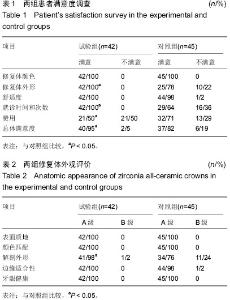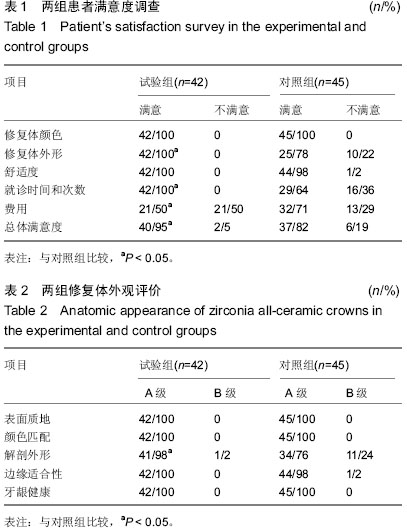| [1] Bogna S,Mutlu O,Malgorzata R,et al. Load-bearing capacity and failure xirconia cro types of anterior wns veneered with overpressing and layering techniques.Dent Mater.2011;27(10): 1045-1053.
[2] Tinscherf J,Natt G,Spiekemann H,et al.Fracture resistance of lithium disilicat-,alumina-and zirconia-based three unit fixed denture:a laboratory study.Int J Prosthodont.2001;14(3): 231-238.
[3] 杨宇.二氧化锆内冠染色用于前牙美容修复的效果分析[J].中国基层医药,2012,19(19):2980-2981.
[4] 刘宇,章禾,林松杉,等.40单位inCoris ZI二氧化锆CAD/CAM种植修复体的临床观察[J].中国口腔种植学杂志,2011,16(1):22-23.
[5] 吴茫茫,张先琴.二氧化锆全瓷系统在口腔修复科中的临床应用与发展趋势[J].中国实用医药,2014,5(27):83-84.
[6] 杨惠,王敏,邹海啸,等.二氧化锆和钛愈合基台周围龈沟液中AST含量的比较研究[J].牙体牙髓牙周病学杂志,2014,24(1):26-29.
[7] 姚希,李昀生,胡冬梅,等.不同材料烤瓷冠在后牙种植修复中的对比[J].中国组织工程研究,2014,18(12):1858-1863.
[8] 洪凌斐,张丽霞,乐群,等.2种粘结剂及粘结方法对CAD/CAM全瓷冠抗折强度的影响[J].口腔医学,2014,34(2):114-117.
[9] Kohorst P, Brinkmann H,Li J,et al. Marginal accuracy offour-unit zirconia fixed dental prostheses fabricated using different computer aided design/computer aided manufacturing systems.Eur J Oral Sci.2009;117(3):319-325.
[10] 关昌俊,陈小冬,邢文忠. 评价不同瓷贴面修复材料制作修复体颜色的匹配性[J].中国组织工程研究,2014,18(25):3942-3946.
[11] 武庆华,张晓东,朱坤,等.二氧化锆全瓷冠在前牙修复中的临床应用研究[J].中华全科医学,2014,12(6):866-868.
[12] 李春生.二氧化锆全瓷冠与金属烤瓷冠在前牙修复中的应用研究[J].海南医学院学报,2013,19(3):396-398.
[13] 崔广,王茵,唐伟华,等.CAD/CAM全解剖形态氧化锆修复体在后牙固定修复中的应用[J].中华临床医师杂志(电子版),2013,7(21): 154-156.
[14] Ohhof LW,van Der Zel JM,de Ruiter WJ,et al.Computer modeling of ocelusal surfaces of posterior teeth with the CICERO CAD/CAM system.J Prosthet Dent.2000;8(2): 154-162.
[15] 孙凤,张桂荣,张峰,等.CAD/CAM氧化锆全瓷在口腔修复领域的应用[J].上海口腔医学,2006,15(4):337-344.
[16] 冯志俊,曾豪.CAD/CAM二氧化锆全瓷冠与烤瓷熔附金属全冠的临床应用研究[J].临床医药实践,2014,23(5):325-328.
[17] 贾胜男,罗佳,林野,等.计算机辅助导航技术在口腔种植手术中的应用[J].中华口腔医学杂志,2014,61(6):379-382.
[18] Persson AS,Andersson M,Oden A,et al.Computer aided analysis of digitized dental stone replicas by dental CAD/CAM technology.Dent Mater.2008;24(8):1123-1130.
[19] Miyazaki T,Hotta Y,Kunii J,et al.A review of dental CAD/CAM: current status and future per- spectives from 20 years of experience.Dent Mater J.2009;28(1):44-56.
[20] Poticny DJ,Klim J.CAD/CAM in-office technology: innovations after 25 years for predictable,esthetic outcomes.JADA.2010; 141(Suppl 2):5S-9S.
[21] 柴枫,徐凌,廖运茂,等.氧化锆增韧的纳米复合渗透陶瓷粉体性能的研究[J].实用口腔医学杂志,2002,18(6):518-521.
[22] 肖静,滕伟.三维数字化扫描在口腔修复领域中的应用[J].国际口腔医学杂志,2014,41(1):63-67.
[23] 徐明明,刘峰.CAD/CAM技术在口腔修复中的应用-数字印模技术[J].中国实用口腔科杂志,2013,5(6):321-326.
[24] 周晓琴,周诺,许胜,等.CAD/CAM氧化锆全瓷冠与钴铬合金烤瓷冠返工率比较及原因探讨[J].广西医科大学学报,2014,31(3): 380-381.
[25] Austin RE,Antonyshyn OM.Current applications of 3-d intraoperative navigation in craniomaxillofacial surgery : a retrospective clinical review.Ann Plast Surg. 2012;69(3): 271-278.
[26] Rasimick BJ,Wan J,Musikant BL,et al.A review of failure modes in teeth restored with adhesively luted endodontic dowels.J Prosth odont.2010;19(8):639-646.
[27] 符镇南,张佩芬,陈儒娜,等.CAD/CAM一体化氧化锆桩核的临床评价[J].口腔颌面修复学杂志,2013,14(1):43-46.
[28] 贾新宇.评价计算机辅助设计与计算机辅助制作氧化锆全瓷冠与金合金烤瓷冠临床修复效果[J].临床医药实践,2012,21(6): 424-426.
[29] 蒋元源,凌翔,李倩,等.CAD/CAM氧化锆全瓷冠修复临床疗效评价[J].临床口腔医学杂志,2012,28(11):685-686. |



